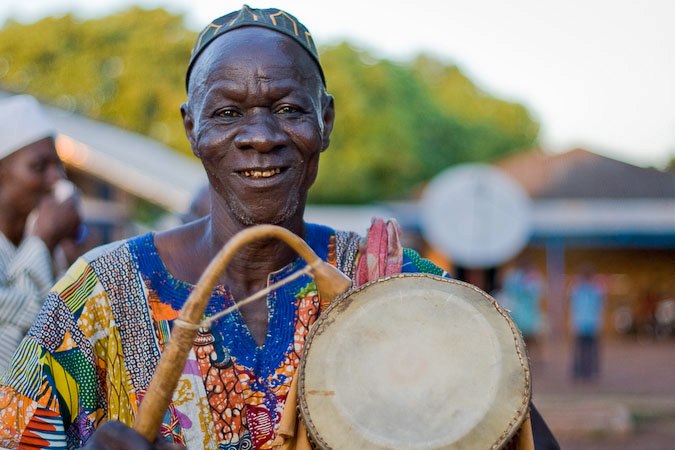Yong Duuni community (Naa Nyagse and the expansion of Dagbon Kingdom)
The Tatale hills, the Yong Duuni community, where the adventurous Yaa Naa Nyagsi, son of Naa Shitobu and grandson of Naa Gbewaa died after killing the Tindana (Chief Priest) of Yong Duuni in 1432. His tomb to date still exists.
After the conquest in Western Dagbon, Naa Nyagse crossed the Oti River into Eastern Dagbon were he conquered Zabzugu installing his son Yalem chief and then proceeded to Nakpali and enskinned Yembageya. Next came Salenkogu, where his grandson, Nguhuriba was appointed chief and Tagnemo, went to another grandson, Kabiun.
Naa Nyagse then returned to Yogu and killed the Tendana of Namogu. It was while at Yogu that Naa Nyagse built Yani Dabari where he died in 1432.
German Cemetery in Yendi (German Cemetery in Yendi: Resting Place of the Warriors of Adibo Battle)
Dagbon Kingdom was threatened by the Europeans from all directions – from the south by the Germans, from the West by the British and from the North by the French. In all Dagbon resisted colonialism for several years.
The graves of the notorious slave raider, Babato. The German cemetery in Yendi where most of the victims of the Adibo Battle were laid to rest.
Following their resistance against foreign authority, on 3rd December 1896, the Dagbamba tribesmen met and launched an attack on the heavily armed German Schutztruppe and Askari paramilitary police accompanying the Lieutenant Valentin von Massow on his way to their capital at the village of Adibo, who had been sent by the German colonial administration to quell the rebellion.
One man whose name comes out for his bravery on the battle days in 1896 was the chief of Gbungbaliga, Kanbon-nakpem Ziblim. He had promised the Ya Na that he would apprehend any white-man who would step foot in Dagbang.
This chief warrior was indeed a remarkable soldier and fighter, well built, brave, and an inspiration to his troops. He was affectionately called Kanbon-nakpem Wohu and rode a white stallion horse, carried two guns and a sword to match his status.
The First Gbewaa Palace (After the death of Naa Gbewaah; the power struggle between Zirli & Kufogu)
When Tohadzie was rewarded with a Malian princess, PAGAWUBGA, for a wife. The Malian princess gave birth to a son, KPOGNAMBO, who grew up and exhibited bravery and warrior acuity similar to his father’s. Kpognambo traveled westwards from the Mali Empire to Biun, in Fadan Grumah, where after defeating the TENDANA became chief of Biun.
Kpognambo married two women; Sihisabiga (daughter of the Fetish Priest of Biun) and Suhuyini (daughter of the King of Fadan Grumah). Suhuyini gave birth to Gbewaah
In the thirteenth century, Gbewaah migrated with a large following to Pusiga. Pusiga is in the Upper East region of present-day Ghana. Naa Gbewaah established the Kingdom of Greater (Ancient) Dagbon, which he ruled until his death. In Pusiga the chieftainship of the Kingdom of Greater Dagbon became known as NAM which was the preserve of the male children of Naa Gbewaah.
Yani Dabari (Diyali)
Sitobu one of the 5 known sons of Gbewaa founded the kingship known today as Ya Naa, literally meaning King of strength (power). Sitobu subsequently settled briefly at Gambaga before moving south to Namburugu, near Karaga, where he founded the modern Dagbon state. After the death of Sitobu he was succeeded by his son Naa Nyagse who spread the Kingdom of Dagbon in all four directions.
Upon ascension to the skins of Yani, Naa Nyagse made war on the Dagbon Sablisi (Black Dagbamba) and founded YANI DABARI as the new seat (capital) of the Kingdom. Yani Dabari is located at Diyali near Tamale. In about 1700, the capital was relocated from Yani Dabari to a new city also known as Yani (Yendi) in the east because of incessant wars with neighbors.
Yendi Gbewaa Palace
The centuries-old Naa Gbewaa Palace in yendi, built between 1554 and 1570 AD by Yaa Naa Luro. The Gbewaa Palace is the seat of the King of Dagbon and has stood since the mid-1500s, even though it was burnt down by the Germans in the Battle of Adibo in 1896.
The German Schutztruppe and Askari paramilitary police led by the Lieutenant Valentin von Massow burnt down the Palace and the entire Yendi village after the Battle of Adibo on December 4, 1896. However, the Palace was later built again by Yaa Naa Alassani in 1899 and it has since stood.
Bagli Community
Bagli, now a farming community in the Karaga District. Sitobu subsequently settled briefly at Gambaga before moving south to Namburugu, near Karaga, where he founded the modern Dagbon state.
In this community lies the tomb of Yaa Naa Shitobu, the founder of the Dagbon Kingdom who according to Dagbon historians died in 1414. His tomb has become a shrine where the Chief of the area, the Bagli Tindana guards. An age-long practice of serving the tomb supper is still practiced even today.
Adibo Community (The Battle of Adibo fought in 1896)
Adibo community is sited on the Yendi-Bimbilla road, this is the village where the Germans first came into contact with the Dagomba forces in Battle of Adibo, till date, according to some residents, traces of the war are still very visible at the specific place of the battle and somewhat sacred now.
The battle of Adibo is remembered in Dagbang as a solemn occasion, the Ya Na stays indoors and must not appear in public on any market day that falls on a Friday (Alizumma koofe).








